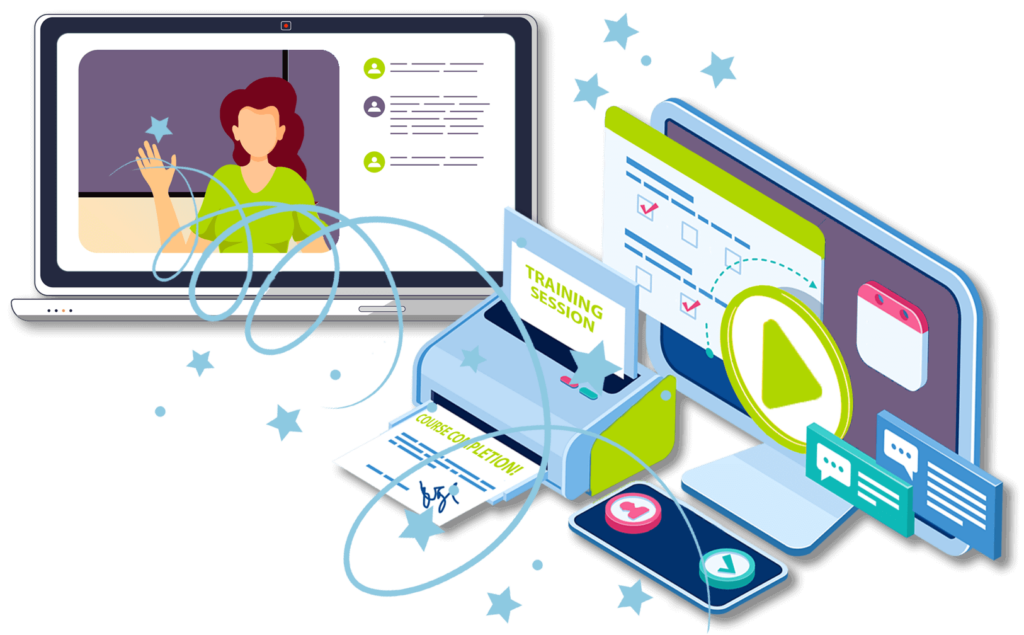Convert Webinars into Online Learning: Maximizing Engagement and Accessibility
Written by Dr. Diana Brandon
For many, webinars were a first step into online learning. They were relatively simple to create—often just a speaker talking to the camera—and became essential for professional development and e-learning, especially during the COVID-19 pandemic, when in-person training wasn’t an option for most organizations. Webinars were the logical choice due to their many benefits:
- Low-Cost Production: Webinars can be produced with basic software subscriptions and knowledgeable content experts.
- Post-Production Revenue: Recorded webinars can be sold as part of an online course catalog.
- Interactivity: Webinars allow some level of interaction through pre-submitted questions or live participant engagement.
However, many organizations now have a catalog of webinars that aren’t effectively meeting current learning needs. Hour-long video recordings lack engagement, often have no assessments to check for understanding, are rarely accessible for those with visual or auditory impairments, and may contain outdated information.
Why Webinars Are No Longer Enough
To meet the demand for more flexible and scalable training, converting webinars into online learning offers significant value for both learners and the organization. By transforming time-bound webinars into on-demand, self-paced learning experiences, you provide flexible educational opportunities that better meet employees’ needs—while maximizing the value of your existing recordings.
1. Flexibility: Learners Control When and How They Learn
One major limitation of webinars is that learners must participate at a specific time. This can be challenging for organizations with employees working different shifts, across various time zones, or with demanding schedules. In fact, a study by Bates (2020) found that 74% of adult learners view flexible scheduling as a key factor in choosing online learning programs.
Another issue of webinars is limited interactivity; audience questions, often the only interactive element, are inaccessible to most potential participants. While recorded webinars help by allowing access after the live event, they usually result in lengthy videos with no required interaction.
Converting webinars into online learning removes these barriers, allowing learners to engage with content at their own pace and on their own schedule. This format (known as asynchronous) also reduces bandwidth requirements, as courses can load faster and require less data than full-length video recordings. Asynchronous learning allows employees to pursue professional development on their own terms in industries like healthcare and utilities, where shift work and unpredictable schedules are common.
2. Increased Access: Overcoming Geographic and Technological Barriers
Webinars often require a stable internet connection and real-time participation, posing challenges for employees in remote or rural areas or those with limited access to technology. This issue persists even with hour-long video recordings from live sessions. According to research by the International Society for Technology in Education (ISTE, 2020), asynchronous learning formats enable learners to access materials on various devices and at differing levels of internet connectivity.
Converting webinars into online learning eliminates the need for live attendance and reduces the bandwidth demands. Asynchronous courses incorporate text-based content, still images, and shorter video clips, making them less data-intensive than long-form videos. Learners can also download or stream content at a time and place that best suits their circumstances.
In industries such as agriculture or manufacturing, employees may work in areas with unreliable internet. Asynchronous courses allow them to download materials when connectivity is available and complete training offline if necessary. This approach ensures that all employees have equal access to professional development opportunities regardless of location or technology constraints.

3. Longevity: Extending the Life of Time-Sensitive Content
Webinars are often created as time-sensitive events, addressing specific issues or topics relevant at a particular moment. However, much of the content remains valuable long after the live session ends. According to the Association for Talent Development (ATD, 2020), converting live training into on-demand courses can increase the longevity of educational programs by 60%, allowing for incremental updates to maintain relevance while reducing the time and cost of developing new materials. By transforming webinars into asynchronous courses, you extend the lifespan of your content, making it reusable and accessible to future learners.
Creating evergreen content—material that remains relevant over time—is especially important in industries with constantly evolving regulations, like healthcare, legal, or manufacturing, where compliance is essential. For instance, a webinar on Occupational Safety and Health Administration (OSHA) regulations might focus on recent updates, but the foundational principles of safety compliance remain applicable for years. By converting this content into an on-demand course, organizations can provide long-lasting, relevant training and update sections as new regulations emerge.
4. Enhanced Learning Experience: Opportunities for Deeper Engagement
Webinars are usually time-limited, restricting the depth of content covered and the number of examples provided. Additionally, webinars do not require active engagement from learners; they can simply press play and disconnect, with limited interaction even in live sessions, which may only allow for Q&A. Studies show that interactive, self-paced learning environments can boost knowledge retention by up to 40%, compared to traditional lecture-based formats (Clark & Mayer, 2016).
Asynchronous courses offer organizations the chance to create a more engaging learning experience. They allow learners to revisit materials, practice applications, and interact meaningfully with the content. Converting webinar content into an asynchronous format supports a more thoughtful design that can include multimedia, quizzes, and scenario-based activities to encourage deeper engagement.
In fields like law or education, where a nuanced understanding of complex concepts is crucial, adding these elements helps learners absorb and apply material more effectively. For example, a lawyer taking a course on data privacy laws could benefit from an interactive case study or assessment to test their understanding. This experience may not fit within the constraints of a live webinar.
5. Scalability: Reaching a Larger Audience with Less Effort
One of the greatest advantages of converting webinars into asynchronous courses is scalability. Once created, the content can be reused with minimal additional effort or cost. According to a report from eLearning Industry (2021), converting live webinars to asynchronous courses can reduce training costs by up to 50% and increase scalability, enabling organizations to reach a wider audience with fewer resources (eLearning Industry, 2021). This is especially valuable for larger organizations or those with multiple locations, as it allows them to deliver consistent, high-quality training without the logistical challenges of scheduling live sessions.
Asynchronous courses enable employees at any location to access the same training in industries like automotive or manufacturing, where multiple facilities may operate across the country or internationally. This approach ensures consistent learning experiences across the organization and eases the workload on HR and training departments.
6. Learner Autonomy: Encouraging Self-Directed Learning
Another key benefit of asynchronous courses is that they promote self-directed learning, a foundational principle of adult education. Research in adult learning theory suggests that self-directed learning leads to better outcomes, as learners are more engaged with content when they control the learning process (Knowles, Holton, & Swanson, 2015). This approach aligns with adults’ preference for autonomy, allowing them to engage with the material in ways that best suit their needs, interests, and schedules.
Asynchronous courses enable learners to revisit content, explore supplementary materials, and complete activities at their own pace, fostering a deeper sense of ownership over their learning journey. This is especially beneficial in fields like healthcare or education, where professionals may need to revisit complex content or refresh skills at different points in their careers. By offering asynchronous courses, organizations support this autonomy and enhance overall learning outcomes.

7. Continuous Improvement: Leveraging Analytics for Better Course Design
Another major advantage of converting webinars into asynchronous courses is the ability to gather data and analyze learner behavior. Tracking how participants engage with the content is challenging with live or recorded webinars. However, asynchronous courses provide detailed insights, including completion rates, quiz scores, time spent on specific sections, and more.
This data allows organizations to continuously improve their courses based on learner feedback and performance. For example, if a high percentage of learners struggle with a particular module, the issue can be identified, and adjustments made to enhance understanding. Research shows that incorporating data analytics in online learning can increase the effectiveness of educational programs by up to 30%, enabling organizations to refine content and improve learner outcomes (West, 2019). This iterative process leads to higher-quality training programs over time.
Conclusion: Why Converting Webinars into Online Learning Offers Lasting Value
For organizations aiming to provide impactful professional development, converting webinars into asynchronous courses offers numerous benefits for both learners and the organization. From increased flexibility and scalability to enhanced learner engagement and continuous improvement, asynchronous courses deliver a lasting, high-impact training solution. By investing in this transition, organizations can ensure that their learning content remains relevant, accessible, and valuable to employees across various industries.
Bonus: Discovering Revenue in Your Existing Content
Ready to start but facing budget constraints? Many organizations have valuable webinar content saved but lack the resources to convert it into an asynchronous format. If these recordings are generating revenue, it is likely limited. Converting just one webinar could open a new revenue stream and provide a stronger return on your existing content. Contact the DOC today to discuss your goals—we can help you explore creative funding solutions to get started.
Sources
Bates, A. W. (2020). Teaching in a Digital Age: Guidelines for Designing Teaching and Learning. Tony Bates Associates Ltd.
Smith, J. (2021). “The Benefits of Flexibility in Adult Learning.” Journal of Adult Education and Learning Development, 29(3), 45-56.
ISTE (2020). “Bridging the Digital Divide with Asynchronous Learning.” International Society for Technology in Education.
ATD (2020). “The Value of On-Demand Learning.” Association for Talent Development.
Clark, R. C., & Mayer, R. E. (2016). E-Learning and the Science of Instruction: Proven Guidelines for Consumers and Designers of Multimedia Learning. Wiley.
Knowles, M. S., Holton, E. F., & Swanson, R. A. (2015). The Adult Learner: The Definitive Classic in Adult Education and Human Resource Development. Routledge.
West, D. M. (2019). “Data Analytics in Online Education: Driving Continuous Improvement.” Journal of Online Education, 17(2), 90-102.
eLearning Industry (2021). “Cost Reduction and Scalability Through Asynchronous Learning.” eLearning Industry.









